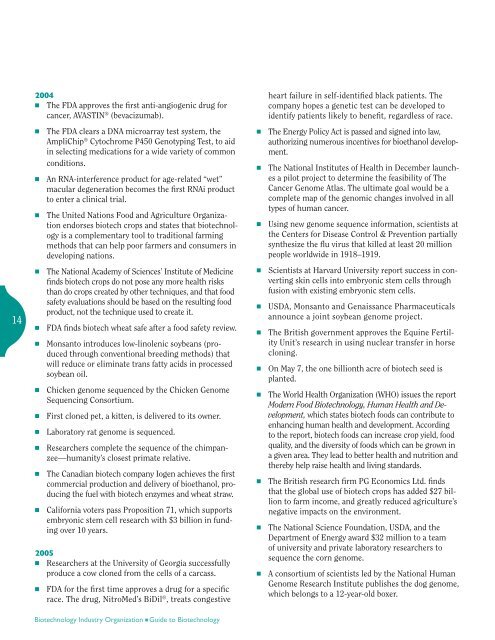Introduction Guide to Biotechnology - Biomolecular Engineering Lab
Introduction Guide to Biotechnology - Biomolecular Engineering Lab
Introduction Guide to Biotechnology - Biomolecular Engineering Lab
Create successful ePaper yourself
Turn your PDF publications into a flip-book with our unique Google optimized e-Paper software.
14<br />
2004<br />
n The FDA approves the first anti-angiogenic drug for<br />
cancer, Avastin ® (bevacizumab).<br />
n The FDA clears a DNA microarray test system, the<br />
AmpliChip ® Cy<strong>to</strong>chrome P450 Genotyping Test, <strong>to</strong> aid<br />
in selecting medications for a wide variety of common<br />
conditions.<br />
n An RNA-interference product for age-related “wet”<br />
macular degeneration becomes the first RNAi product<br />
<strong>to</strong> enter a clinical trial.<br />
n The United Nations Food and Agriculture Organization<br />
endorses biotech crops and states that biotechnology<br />
is a complementary <strong>to</strong>ol <strong>to</strong> traditional farming<br />
methods that can help poor farmers and consumers in<br />
developing nations.<br />
n The National Academy of Sciences’ Institute of Medicine<br />
finds biotech crops do not pose any more health risks<br />
than do crops created by other techniques, and that food<br />
safety evaluations should be based on the resulting food<br />
product, not the technique used <strong>to</strong> create it.<br />
n FDA finds biotech wheat safe after a food safety review.<br />
n Monsan<strong>to</strong> introduces low-linolenic soybeans (produced<br />
through conventional breeding methods) that<br />
will reduce or eliminate trans fatty acids in processed<br />
soybean oil.<br />
n Chicken genome sequenced by the Chicken Genome<br />
Sequencing Consortium.<br />
n First cloned pet, a kitten, is delivered <strong>to</strong> its owner.<br />
n <strong>Lab</strong>ora<strong>to</strong>ry rat genome is sequenced.<br />
n Researchers complete the sequence of the chimpanzee—humanity’s<br />
closest primate relative.<br />
n The Canadian biotech company Iogen achieves the first<br />
commercial production and delivery of bioethanol, producing<br />
the fuel with biotech enzymes and wheat straw.<br />
n California voters pass Proposition 71, which supports<br />
embryonic stem cell research with $3 billion in funding<br />
over 10 years.<br />
2005<br />
n Researchers at the University of Georgia successfully<br />
produce a cow cloned from the cells of a carcass.<br />
n FDA for the first time approves a drug for a specific<br />
race. The drug, NitroMed’s BiDil ® , treats congestive<br />
heart failure in self-identified black patients. The<br />
company hopes a genetic test can be developed <strong>to</strong><br />
identify patients likely <strong>to</strong> benefit, regardless of race.<br />
n The Energy Policy Act is passed and signed in<strong>to</strong> law,<br />
authorizing numerous incentives for bioethanol development.<br />
n The National Institutes of Health in December launches<br />
a pilot project <strong>to</strong> determine the feasibility of The<br />
Cancer Genome Atlas. The ultimate goal would be a<br />
complete map of the genomic changes involved in all<br />
types of human cancer.<br />
n Using new genome sequence information, scientists at<br />
the Centers for Disease Control & Prevention partially<br />
synthesize the flu virus that killed at least 20 million<br />
people worldwide in 1918–1919.<br />
n Scientists at Harvard University report success in converting<br />
skin cells in<strong>to</strong> embryonic stem cells through<br />
fusion with existing embryonic stem cells.<br />
n USDA, Monsan<strong>to</strong> and Genaissance Pharmaceuticals<br />
announce a joint soybean genome project.<br />
n The British government approves the Equine Fertility<br />
Unit’s research in using nuclear transfer in horse<br />
cloning.<br />
n On May 7, the one billionth acre of biotech seed is<br />
planted.<br />
n The World Health Organization (WHO) issues the report<br />
Modern Food <strong>Biotechnology</strong>, Human Health and Development,<br />
which states biotech foods can contribute <strong>to</strong><br />
enhancing human health and development. According<br />
<strong>to</strong> the report, biotech foods can increase crop yield, food<br />
quality, and the diversity of foods which can be grown in<br />
a given area. They lead <strong>to</strong> better health and nutrition and<br />
thereby help raise health and living standards.<br />
n The British research firm PG Economics Ltd. finds<br />
that the global use of biotech crops has added $27 billion<br />
<strong>to</strong> farm income, and greatly reduced agriculture’s<br />
negative impacts on the environment.<br />
n The National Science Foundation, USDA, and the<br />
Department of Energy award $32 million <strong>to</strong> a team<br />
of university and private labora<strong>to</strong>ry researchers <strong>to</strong><br />
sequence the corn genome.<br />
n A consortium of scientists led by the National Human<br />
Genome Research Institute publishes the dog genome,<br />
which belongs <strong>to</strong> a 12-year-old boxer.<br />
<strong>Biotechnology</strong> Industry Organization n <strong>Guide</strong> <strong>to</strong> <strong>Biotechnology</strong>
















